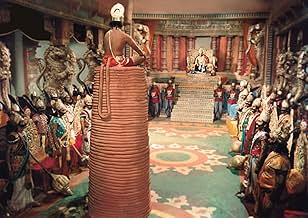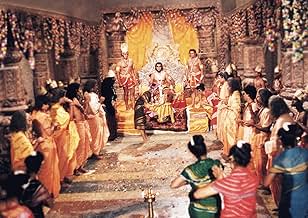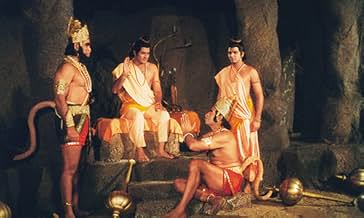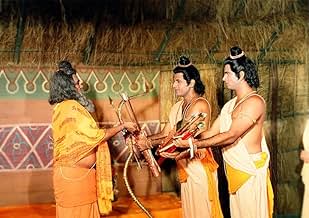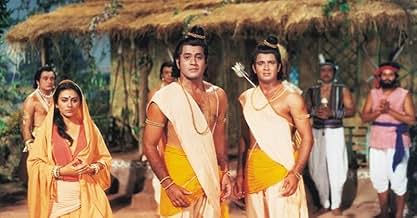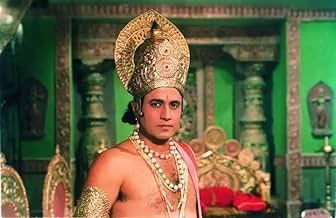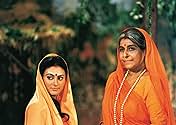Ajouter une intrigue dans votre langueAn adaptation of the ancient epic in which the exiled Prince Rama and his brother Laxman set out to save Rama's wife, Sita, who has been kidnapped by the demon king of Lanka Ravana.An adaptation of the ancient epic in which the exiled Prince Rama and his brother Laxman set out to save Rama's wife, Sita, who has been kidnapped by the demon king of Lanka Ravana.An adaptation of the ancient epic in which the exiled Prince Rama and his brother Laxman set out to save Rama's wife, Sita, who has been kidnapped by the demon king of Lanka Ravana.
- Prix
- 1 victoire et 1 nomination au total
Parcourir les épisodes
Sommaire
Reviewers say 'Ramayan' directed by Ramanand Sagar is celebrated for its faithful adaptation of Hindu mythology, capturing cultural essence and emotional impact. Performances by Arun Govil, Deepika, and Dara Singh are highly commended. Ravindra Jain's music enhances the narrative. Despite criticisms of production values and special effects, the series is lauded for its cultural significance and profound societal impact during its original airing.
Avis en vedette
Ramanand Sagar researched many versions of the countless Ramayan written by countless poets in the journey to produce this masterpiece. This version of the Ramayan is mainly based on Goswami Tulsidas Shree Ramcharitmanas. Even after almost 30 years and many follow-on versions and attempts by others, the depiction and narration by Ramanand Sagar is on a different plane. The music, visuals and singers are all enchanting due to the innocence and the type of cinema of the 1980s. Ramanand Sagar managed to extract near perfect performances from all the characters of his cast. Thank you to Ramanand Sagar for producing this masterpiece.
10DrEbert
When "Ramayan" aired, India (even then having a population over 900 million) came to a standstill. Buses stopped running, religious services (Hindu and non-Hindu) were rescheduled, and everyone stopped what they were doing for 30 minutes every Sunday morning to watch the ancient Indian epic brought to life on television. It's hard to believe that something like that is possible, but it really happened. Despite being dismissed by some as a cheap production with garish sets, cheesy special effects, and melodramatic dialogue, "Ramayan" was and continues to be a phenomenon.
True, the production is quite obviously very low budget and it shows in the special effects and sets. (Tollywood director Bapu's "Seeta Kalyanam" a.k.a. "Seeta Swayamvar" shows a much better production, even though it, too, was low-budget.) Some of the same actors are used repeatedly for various minor roles and voices. At times, it does look like a high school production.
But, what Ramanand Sagar (who, in my opinion, is otherwise a mediocre filmmaker) has done here is spectacular. Despite all of the above, "Ramayan" works incredibly well because one can sense that a great deal of devotion went into making it. This is a series that really has a heart and soul. Every time I watch "Ramayan," I have a religious experience.
The dialogue might sound melodramatic to some (and sometimes it is), but the script is extremely faithful to the original texts that it is based off of. Sometimes, lines are directly quoted from Valmiki or Tulsidas and translated into Hindi. "Ramayan" takes very little dramatic license and so what is presented on screen is an accurate presentation of the source texts. This gives "Ramayan" value not only to devout Hindus but also to students of Hindu religion and Indian epic poetry, both of whom can watch the series and get a good understanding of the works of Valmiki, Tulsidas, and others. The feeling conveyed in the television series is the feeling conveyed from a recital of the epic itself.
What also helps this series tremendously is the music by Ravindra Jain. Indian storytelling in general (both in film and in religious sermons) has a tradition of mixing dialogue with songs. Here, Ravindra Jain uses music to its fullest advantage. There are plenty of songs throughout the series, but they are placed in perfect situations. This is not the typical Bollywood style of breaking into song and dance at random and inappropriate places. Instead, rather than boring the audience with a long battle scene filled with cheap special effects, the battle is shown with a song describing the battle. Scenes of devotion naturally have devotional music with them. Transition scenes are accompanied by lines of Tulsidas. In fact, Jain sometimes cleverly and seamlessly merges his own lyrics with the poetry of Tulsidas, creating songs that are modern masterpieces of music.
I'm generally satisfied with the casting choices. Arun Govil and Deepika do well as Rama and Sita. Dara Singh is not an incredibly talented actor (he is originally a wrestler), but it worked for me to have him as Hanuman. My three favorite performances, though, are Sunil Lahri as Lakshmana (he's got Lakshmana's angry look down perfectly), Vijay Arora as Indrajit (he's got the boisterous personality down), and veteran character actress Lalita Pawar as Manthara (a perfect choice, as Pawar made a career out of playing literally hundreds of Manthara-like characters). Arvind Trivedi is not bad as Ravana, but he does not have the physically dominating presence that Ravana would need to have. Ravana should be tall, dark, muscular, and handsome, and Trivedi is none of those things. Still, not a bad performance on his part. (As an aside, the single worst casting choice is the actor picked to play Parshurama in one episode early on in the series; they picked somebody less than 5 feet tall to play a domineering character and it completely doesn't work.)
We tend to put all of that aside, though, because of just how well the story works for us. "Ramayan" made religion fashionable on Indian television. This is why some scholars list Ramanand Sagar (who, I reiterate, was an otherwise mediocre filmmaker) as one of 4 men (along with Valmiki, Tulsidas, and Kamban) who has shaped modern interpretations of the Ramayana story. That is quite an achievement, to be one of the four main forces that guide a tradition that dates back thousands of years, all on a budget (I'm told) of Rs. 100,000 per episode.
Really, I've already said more than needs to be said. All that really needs to be said is that "Ramayan" brought India to a STANDSTILL!
True, the production is quite obviously very low budget and it shows in the special effects and sets. (Tollywood director Bapu's "Seeta Kalyanam" a.k.a. "Seeta Swayamvar" shows a much better production, even though it, too, was low-budget.) Some of the same actors are used repeatedly for various minor roles and voices. At times, it does look like a high school production.
But, what Ramanand Sagar (who, in my opinion, is otherwise a mediocre filmmaker) has done here is spectacular. Despite all of the above, "Ramayan" works incredibly well because one can sense that a great deal of devotion went into making it. This is a series that really has a heart and soul. Every time I watch "Ramayan," I have a religious experience.
The dialogue might sound melodramatic to some (and sometimes it is), but the script is extremely faithful to the original texts that it is based off of. Sometimes, lines are directly quoted from Valmiki or Tulsidas and translated into Hindi. "Ramayan" takes very little dramatic license and so what is presented on screen is an accurate presentation of the source texts. This gives "Ramayan" value not only to devout Hindus but also to students of Hindu religion and Indian epic poetry, both of whom can watch the series and get a good understanding of the works of Valmiki, Tulsidas, and others. The feeling conveyed in the television series is the feeling conveyed from a recital of the epic itself.
What also helps this series tremendously is the music by Ravindra Jain. Indian storytelling in general (both in film and in religious sermons) has a tradition of mixing dialogue with songs. Here, Ravindra Jain uses music to its fullest advantage. There are plenty of songs throughout the series, but they are placed in perfect situations. This is not the typical Bollywood style of breaking into song and dance at random and inappropriate places. Instead, rather than boring the audience with a long battle scene filled with cheap special effects, the battle is shown with a song describing the battle. Scenes of devotion naturally have devotional music with them. Transition scenes are accompanied by lines of Tulsidas. In fact, Jain sometimes cleverly and seamlessly merges his own lyrics with the poetry of Tulsidas, creating songs that are modern masterpieces of music.
I'm generally satisfied with the casting choices. Arun Govil and Deepika do well as Rama and Sita. Dara Singh is not an incredibly talented actor (he is originally a wrestler), but it worked for me to have him as Hanuman. My three favorite performances, though, are Sunil Lahri as Lakshmana (he's got Lakshmana's angry look down perfectly), Vijay Arora as Indrajit (he's got the boisterous personality down), and veteran character actress Lalita Pawar as Manthara (a perfect choice, as Pawar made a career out of playing literally hundreds of Manthara-like characters). Arvind Trivedi is not bad as Ravana, but he does not have the physically dominating presence that Ravana would need to have. Ravana should be tall, dark, muscular, and handsome, and Trivedi is none of those things. Still, not a bad performance on his part. (As an aside, the single worst casting choice is the actor picked to play Parshurama in one episode early on in the series; they picked somebody less than 5 feet tall to play a domineering character and it completely doesn't work.)
We tend to put all of that aside, though, because of just how well the story works for us. "Ramayan" made religion fashionable on Indian television. This is why some scholars list Ramanand Sagar (who, I reiterate, was an otherwise mediocre filmmaker) as one of 4 men (along with Valmiki, Tulsidas, and Kamban) who has shaped modern interpretations of the Ramayana story. That is quite an achievement, to be one of the four main forces that guide a tradition that dates back thousands of years, all on a budget (I'm told) of Rs. 100,000 per episode.
Really, I've already said more than needs to be said. All that really needs to be said is that "Ramayan" brought India to a STANDSTILL!
This show is masterpiece and is recommended to each and everyone. Thankful to makers of the show that we were witness of the era.
Rama, was such a figure who never went out of the limit. Even he maintained dharma, in even bad and worse time.
This is great learning for the world to understand that in any worse situation, we should not loss control and should not be self centric...
This is great learning for the world to understand that in any worse situation, we should not loss control and should not be self centric...
10vipin88
I saw this series in my childhood and could associate myself only from the religious point of view . Now that I am aware of a little bit working of this world , when I am watching this series again on DVD , I can understand why Ramayana as a epic is so relevant in modern times . It gives a message of love, peace , harmony and dutifulness with the right dose of righteousness in all our actions . The narrative is simple and the characters very true to life .Most of us in India at least understand religion as a sacred duty and not in day to day affairs of life , which ideally it should be. This series , had for the first time explained , with warmth the importance and fun to be righteous and humble in every sphere of daily life . Whoever wishes to improve his life a little more must see and understand from Ramayana.
Le saviez-vous
- AnecdotesAfter being initially rejected by Doordarshan due to perceived lack of interest in religious programming, the series quickly went on to become the most popular series in Indian television history, reaching over 100 million viewers each week. Its popularity reached a point of what the Indian news magazine India Today called "'Ramayan' fever", where religious services were rescheduled, buses, trains, and inter-city trucks were stopped, and shops would close every Sunday at 9:30 a.m. so that people would gather to watch the show. In villages, watching the show became a religious ritual unto itself. The show's popularity would remain the highest in history until a few years later, when Mahabharat (1988), also based on an ancient Hindu epic, would exceed its popularity.
- Autres versionsAfter the sequel series Luv Kush (1988) ended, both the series were aired combined as "Sampurna Ramayan".
- ConnexionsFeatured in We Have Ways of Making You Think: The Power of Soap (1992)
Meilleurs choix
Connectez-vous pour évaluer et surveiller les recommandations personnalisées
- How many seasons does Ramayan have?Propulsé par Alexa
- WHAT IS THE MATTER ?
Détails
- Durée30 minutes
- Couleur
- Rapport de forme
- 4:3
Contribuer à cette page
Suggérer une modification ou ajouter du contenu manquant


